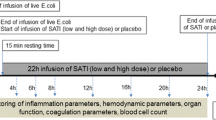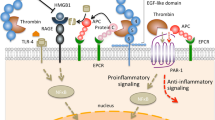Abstract
This review presents the rationale for and main results of coagulation inhibitor substitution during experimental and human sepsis. Activation of the contact system induces activation of the classical complement pathway with generation of anaphylatoxins, of the kinins pathway and of fibrinolysis. Physiologic inhibition depends on the C1-inhibitor (C1-Inh.). Septic patients exhibit a relative deficiency of biologically active C1-Inh. Substitution with concentrations of C1-Inh has been safely performed and preliminary results are consistent with a possible beneficial effect on hypotension and vasopressor requirement in septic shock. The extrinsic pathway is the main initial coagulation process involved in sepsis-induced DIC. Endothelial and monocyte generation of tissue factor (TF) is activated by bacterial products and endotoxin. Activation of TF is counteracted by a specific tissue factor pathway inhibitor (TFPI). The potential for TFPI substitution to inhibit the activation of the coagulation cascade in sepsis requires further study. Thrombin generation is inhibited by antithrombin III (AT III) and the protein C-protein S system. During sepsis, AT III is consumed and degraded by elastase. Animal studies have shown that DIC and death were prevented by high doses of AT III concentrates. Although a significant reduction in the duration of biological symptoms of DIC has been reported in most human studies, the usefulness of AT III substitution in human sepsis is still debated. None of the studies was able to document a statistically significant reduction in mortality. Protein C is activated by thrombomodulin and, with its cofactor protein S, inhibits factors V a and VIII a. The free level of protein S depends on the level of the C4b binding protein (C4 bBP), an acute-phase complement regulatory protein. During sepsis, protein C activity is significantly reduced, either by acute consumption or by thrombomodulin down-regulation, and increased levels of plasma C4 bBP inhibit protein S. Infusion of activated protein C and protein S substitution both protect animals from the lethal effects of bacteria. Combining these different coagulation inhibitors should be carefully studied before its use in septic patients is recommended.
Similar content being viewed by others
References
Müller-Berghaus G (1989) Pathophysiologic and biochemical events in disseminated intra-vascular coagulation: dysregulation of procoagulant and anticoagulant pathways. Semin Thromb Hemost 15:58–87
tenCate H, Brandjes DPM, Wolters HJ, van Deventer SIH (1993) Disseminated intra-vascular coagulation: pathophysiology, diagnosis and treatment. New Horizons 2:312–323
Coleman RW, Wong PY (1977) Participation of Hageman-factor-dependent pathways in human diseases. Thrombos Hemost 38:751–775
Pixley RA, de la Cadena R, Page J, Kaufman N, Wyshock EG, Chang A, Taylor FB, Comman RW (1993) The contact system contributes to hypotension but not disseminated intra-vascular coagulation in lethal bacteremia. J Clin Invest 91:61–68
Waeber G, Schapira M, Waeber B, Aubert JF, Nussberger J, Brunner HR (1988). Hypotensive effect of the active fragment of factor XII is mediated by an activation of the plasma kallikreinkinin system. Circ Shock 26:375–382
Fourrier F, Chopin C, Wallaert B, Mazurier C, Mangalaboyi J, Durocher A (1985) Compared evolution of plasma fibronectin and angiotensin converting enzyme levels in septic ARDS. Chest 87:191–195
Hack CE, Huijens JH, Felt-Bersma RJF, Schreuder WO, Eerenberg-Belmer AJM, Paardekooper J, Bronsveld W, Thijs LG (1989) Elevated plasma levels of the anaphylatoxins C3a and C4a are associated with a fatal outcome in sepsis. Am Med 86:20–26
Fourrier F, Chopin C, Wattre P, Mangalaboyi J, Grimbert I, Zachama B, Wattel F (1982) Activation der la voie classique du complément au cours du syndrome de détresse respiratoire aigu de l'adulte-relations avec les anomalies de l'hémostase. Presse Méd 11: 3707–3711
Herrera C, Velasco F, Guerrero A, Alavrez F, Torres A (1989) Contact phase of blood coagulation in cardiogenic pulmonary edema and adult respiratory distress syndrome. Intensive Care Med 15:99–104
Hack CE, Ogilvie AC, Eisele B, Eerenberg AJM, Wagstaff J, Thijs LG (1993) C1-inhibitor substitution therapy in septic shock and the vascular leak syndrome induced by high doses of interleukin-2. Intensive Care Med 19: S19-S28
Taylor FB (1993) Role of tissue factor in the coagulant and inflammatory response to LD 100E. coli sepsis and the early diagnosis of DIC in the baboon. In: Müller-Berghaus G, Madlener K, Blömback M, Tencate JW (eds) DIC: pathogenesis, diagnosis and therapy of disseminated intra-vascular fibrin formation. Elsevier, New York, pp 19–32
Luther T, Leonhardt U, Sinkwitz KD, Zimmermann T, Albrecht S, Kotzsch M, Muller M (1993) Increase tissue factor plasma levels in patients with septic shock: relation to poor prognosis. Thrombos Hemost 69:671 (Abstr)
Sandset PM, Warn-Cramer BI, Rao LVM, Maki SL, Rapaport SI (1991) Depletion of extrinsic pathway inhibitor (EPI) sensitizes rabbits to disseminated intra-vascular coagulation induced by tissue factor. Evidence supporting a physiological role for EPI as a natural anticoagulant. Proc Natl Acad Sci USA 88:708–712
Higuchi DA, Wun TZ, Likert KM, Broze GJ (1992) The effect of leukocyte elastase on tissue factor pathway inhibitor. Blood 79:1712–1719
Day KC, Hoffmann LC, Palmier MO, Kretzmer KK, Huang MD, Pyla AY, Spokas E, Broze GJ, Warren TG, Wun TZ (1990) Recombinant-lipoprotein-as-sociated coagulation inhibitor inhibits thromboplastin-induced intra-vascular coagulation in the rabbit. Blood 76:1538–1545
Brandtzaeg P, Sandset PM, Waage A, Mollness TE, Oystebo R, Joo GB, Abildgaard U, Kierulf P (1993) Human tissue-factor pathway inhibitor increase in shock and severe DIC is associated with vessel wall damage induced by extreme endotoxemia. Thrombos Hemost 69:505 (Abstr)
Bauer KA, Rosenberg RD (1991) Role of antithrombin III as a regulator of in vivo coagulation. Semin Haematol 28: 10–18
Buller HR, Cate JW (1989) Acquired Antithrombin III deficiency-laboratory diagnosis, incidence, clinical implications and treatment with antithrombin III concentrate. In: Rosenberg R (ed) Role of Antithrombin III in coagulation disorders: state of the art review. Amer J Med 87 [Suppl 3 B]:44s–48s.
Emerson TE, Fournel MA, Redens TB, Taylor FB Jr (1989) Efficacy of antithrombin III supplementation in animal models of fulminantE. coli endotoxemia or bacteremia. In: Rosenberg R (ed) Role of antithrombin III in coagulation disorders. Am J Med 87 [Suppl 3 B]:27s–33s
Seitz R, Wolf M, Egbring R, Radtke KP, Liesenfeld A, Pittner P, Havemann K (1987) Participation and interactions of neutrophil elastase in haemostatic disorders of patients with severe infections. Eur J Haematol 38:231–240
Jordan RE, Kilpatrick J, Nelson RM (1987) Heparin promotes the inactivation of antithrombin by elastase. Science 237:777–775
Fourrier F, Chopin C, Goudemand J, Hendryckx S, Caron C, Rime A, Lestavel P (1992) Septic shock, multiple organ failure and disseminated intravascular coagulation: compared patterns of antithrombin III, protein C and protein S deficiencies. Chest 101: 816–821
Taylor FB Jr, Emerson TE, Jordan R, Chang AK, Bloick KE (1988) Antithrombin III prevents the lethal effects ofE. coli infusion in the baboons. Circ Shock 26:227–235
Dickneite G, Paques EP (1993) Reduction of mortality with antithrombin III in septicemic rats. A study of klebsiella pneumoniae induced sepsis. Thrombos Haemost 69:98–102
Redens TB, Leach WJ, Bogdanoff DA, Emerson TE (1988) Synergistic protection from lung damage by combining antithrombin III and a-1-proteinase inhibitor in theE. coli endotoxemic sheep pulmonary dysfunction model. Circ Shock 26:15–26
Fourrier F, Lestavel P, Chopin C, Marey A, Goudemand J, Rime A, Mangalaboyi J (1990) Meningococcemia and purpura fulminants in adults: acute deficiencies of proteins C and S and early treatment with antithrombin III concentrates. Intensive Care Med 16:1–4
Blauhut B, Necek S, Vinazzer H, Bergmann H (1982) Substitution therapy with an antithrombin III concentrate in shock and DIC. Thromb Res 27: 271–278
Vinazzer H (1989) Therapeutic use of antithrombin III in shock and disseminated intra-vascular coagulation. Semin Thromb Hemost 15:347–352
Fourrier F, Chopin C, Huart JJ, Runge I, Caron C, Goudemand J (1993) Double blind placebo-controlled study of antithrombin III concentrates in septic shock with disseminated intravascular coagulation. Chest 104:882–888
Taylor FB (1993) The protein C system in septic shock. In: Faist, Meakins, Schildberg (eds) Host defense dysfunction in trauma, shock and sepsis. Springer, Berlin, pp 264–276
Hesselvik JF, Malm J, Dahlbäck B, Blömback M (1991) Protein C, protein S and C4b-binding protein in severe infection and septic shock. Thrombos Haemost 65:126–129
Taylor FB, Chang A, Esmon CT, D'Angelo A, Vigano-D'Angelo S, Blick KE (1887) Protein C prevents the coagulopathic and lethal effects ofE. coli in the baboon. J Clin Invest 79:918–924
Okajima K, Imamura H, Koga S, Inoue M, Takatsuki K, Aoki N (1990) Treatment of patients with disseminated intravascular coagulation by protein C. Am J Hematol 33:277–278
Author information
Authors and Affiliations
Rights and permissions
About this article
Cite this article
Fourrier, F., Jourdain, M., Tournois, A. et al. Coagulation inhibitor substitution during sepsis. Intensive Care Med 21 (Suppl 2), S264–S268 (1995). https://doi.org/10.1007/BF01740765
Received:
Accepted:
Issue Date:
DOI: https://doi.org/10.1007/BF01740765




